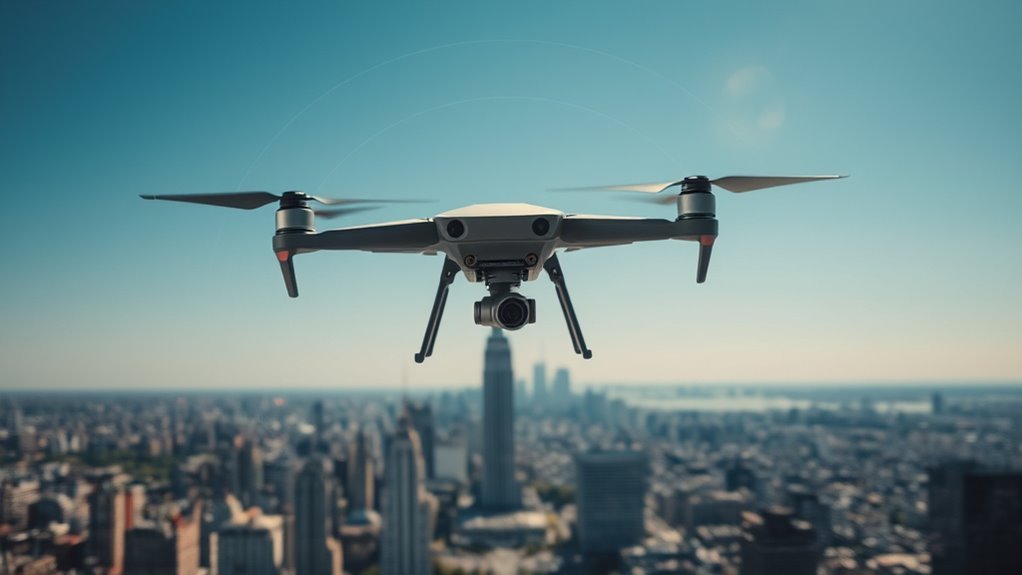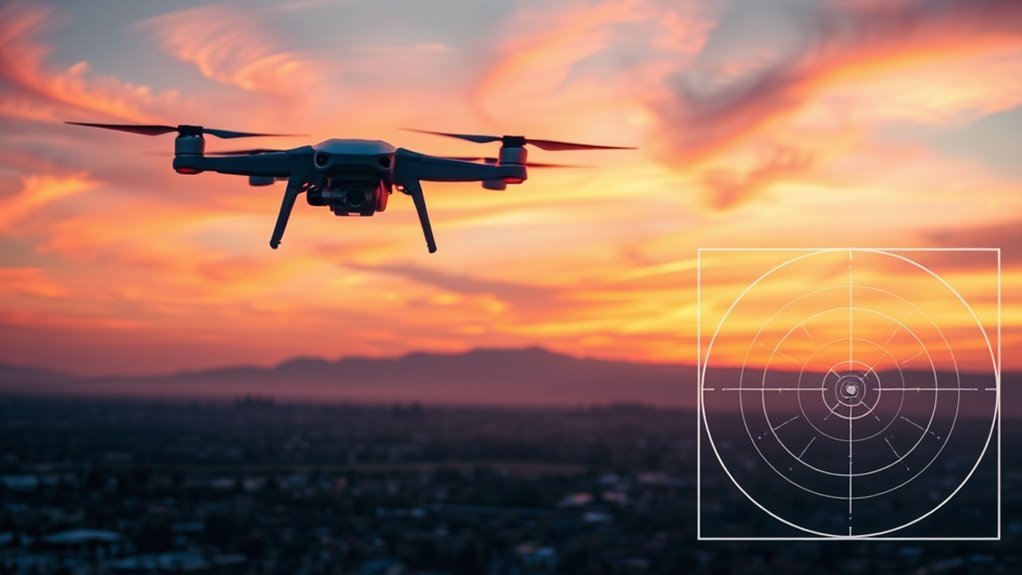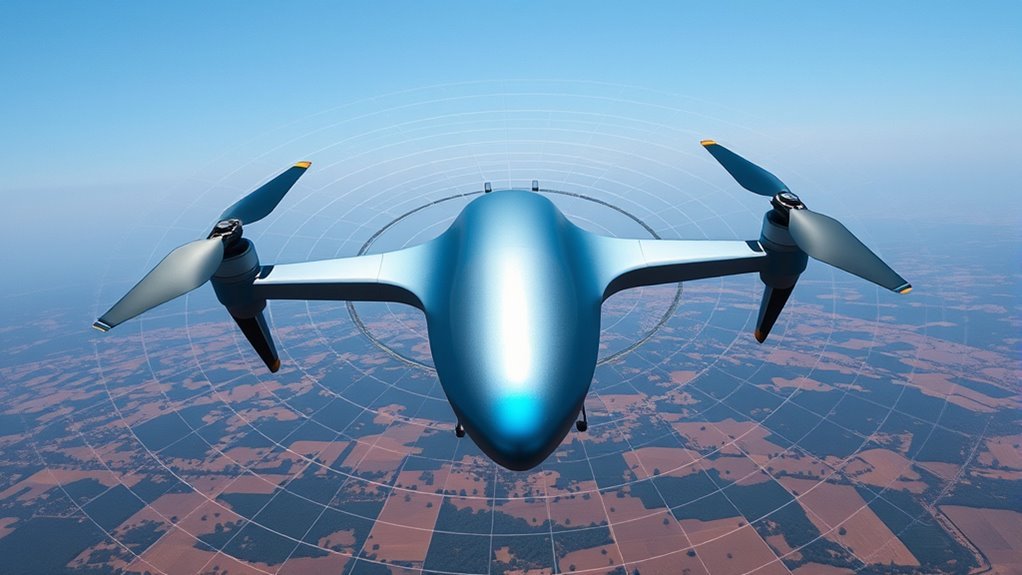You’ll detect drones on radar based on their size, material, altitude, and speed, as well as the radar system’s type and capabilities. Smaller drones with stealth materials like radar-absorbent composites reflect fewer signals, making detection harder. Flight altitude affects signal clarity—low altitudes cause ground clutter, while very high altitudes weaken signals. Speed influences Doppler shifts, aiding target tracking. Environmental conditions and electronic countermeasures further complicate detection. Exploring these factors deeper reveals how complex drone radar identification truly is.
Drone Size and Radar Visibility

Size plays a critical role in a drone’s radar visibility, as smaller drones typically have a reduced radar cross-section (RCS), making them harder to detect. When you consider drone dimensions, the surface area exposed to radar waves directly influences signal reflection strength. Smaller drones present less surface for radar waves to bounce off, resulting in weaker return signals. This challenges radar interpretation systems, which rely on signal intensity and consistency to identify objects. As a result, detecting compact drones requires more sensitive equipment or advanced algorithms to differentiate them from environmental noise. Understanding how drone dimensions affect radar returns empowers you to appreciate the technical limits of radar detection, allowing for informed decisions about drone operation in environments where maintaining freedom of movement is essential.
Material Composition Impact on Radar Detection

You’ll find that the material composition of a drone directly influences its radar signature through surface reflectivity and absorption characteristics. Radar absorbing materials (RAM) can considerably reduce the radar cross-section by attenuating reflected signals. Understanding how different materials interact with radar waves is essential for evaluating detection probabilities.
Radar Absorbing Materials
Although radar detection largely depends on an object’s shape and size, the material composition plays a critical role in how effectively a drone can evade radar signals. You’ll find that radar absorbing materials (RAM) are engineered to reduce radar stealth signatures by converting incident electromagnetic waves into heat, minimizing reflections. These absorption techniques often utilize composites embedded with carbon nanotubes, ferrites, or conductive polymers, which disrupt radar wave propagation. When selecting materials, you must consider their thickness, frequency range, and environmental durability, as these factors directly influence absorption efficiency. By integrating RAM into drone surfaces, you diminish radar cross-section without compromising structural integrity. For those valuing operational freedom, understanding and applying advanced absorption materials is essential to maximizing stealth capabilities and minimizing detectability in contested airspaces.
Reflectivity of Drone Surfaces
Building on the role of radar absorbing materials, the inherent reflectivity of a drone’s surface considerably influences radar detection. When you evaluate a drone’s surface texture, you’ll find it plays a critical role in scattering radar waves. Smooth, metallic surfaces tend to produce stronger radar signatures due to specular reflection, making the drone more detectable. Conversely, matte or irregular textures diffuse radar signals, reducing the intensity of the reflected waves. The material composition also dictates electromagnetic properties that affect reflectivity. By carefully selecting composites with low dielectric constants or incorporating surface treatments, you can minimize the radar signature effectively. Understanding these factors allows you to design drones that better evade radar detection, granting operational freedom and stealth in contested airspace.
Altitude and Its Effect on Radar Signals

When a drone’s altitude changes, it directly influences how radar signals propagate and reflect. Understanding altitude effects is essential because they dictate radar detection efficiency and reveal inherent radar limitations. At lower altitudes, terrain clutter can mask signals, reducing detectability. Higher altitudes generally improve line-of-sight but introduce atmospheric attenuation factors. Specifically, you can visualize altitude effects as:
- Ground clutter interference at low altitudes, causing signal noise and false negatives.
- Enhanced signal clarity at mid-altitudes due to reduced obstructions.
- Atmospheric absorption and scattering at high altitudes, weakening radar returns.
Speed Influence on Radar Tracking
Since radar systems rely on consistent signal reflections to track objects, a drone’s speed considerably impacts tracking accuracy and response time. When you control or monitor a drone, speed variations can cause fluctuations in the Doppler shift of the returned radar signal, affecting how precisely the radar can determine the drone’s position and velocity. Rapid accelerations or erratic movements may produce signal inconsistencies, reducing radar accuracy and complicating target identification. Conversely, steady speeds enhance signal stability, allowing the radar to maintain consistent tracking. Understanding these dynamics empowers you to predict how your drone’s speed influences detection probability. By managing speed variations thoughtfully, you can optimize radar responsiveness or exploit limitations, ultimately gaining greater freedom in maneuvering while balancing the risk of detection.
Types of Radar Systems Used for Drone Detection
Although various radar systems exist, not all are equally effective for detecting drones due to their small size and low radar cross-section. You need to take into account radar frequency and detection range carefully when selecting the appropriate system. Here are three key types:
Not all radar systems detect drones effectively; frequency and range are crucial for optimal selection.
- Pulse-Doppler Radar: Operates at high radar frequencies, offering precise velocity detection and moderate detection range, ideal for distinguishing drones from clutter.
- Continuous Wave (CW) Radar: Uses a steady radar frequency, excels at detecting slow-moving drones within a limited detection range but struggles with range resolution.
- Phased Array Radar: Employs electronically steered beams at variable radar frequencies, providing rapid scanning and extended detection range, essential for freedom-oriented airspace monitoring.
Understanding these systems helps you optimize drone detection strategies without compromising your operational autonomy.
Radar Cross Section of Different Drone Designs
You’ll notice that a drone’s shape greatly affects its radar cross section (RCS), with angular designs typically reducing radar reflections. The materials used in construction also play an essential role, as composites and plastics tend to absorb or scatter radar waves differently than metals. Understanding these factors helps you predict how detectable various drone designs are under radar surveillance.
Shape Impact on Radar
Understanding the shape impact on radar involves analyzing how a drone’s design influences its radar cross section (RCS). The radar signature varies greatly with the drone’s contours and edges. You’ll notice:
- Angular Designs: Sharp angles tend to reflect radar waves away from the source, reducing detectability.
- Smooth, Curved Surfaces: These scatter radar signals in multiple directions, often increasing the RCS.
- Flat, Perpendicular Faces: These act as strong radar reflectors, amplifying the radar signature.
Material Influence on Detection
Since the materials used in drone construction directly affect radar wave absorption and reflection, you need to take into account their electromagnetic properties when evaluating radar cross section (RCS). Material density effects play a significant role; denser materials typically reflect more radar energy, increasing detectability. Conversely, composite materials impact RCS differently due to their ability to absorb and scatter radar signals, often reducing the drone’s radar signature. You should analyze how carbon fiber composites, for instance, lower RCS by minimizing reflected radar waves compared to traditional metal frames. Additionally, the arrangement and layering of composite materials influence radar interaction, enabling design strategies that enhance stealth. Understanding these material characteristics empowers you to optimize drone designs for lower radar visibility, aligning with your goal for operational freedom and reduced detectability.
Environmental Factors Affecting Radar Detection
Although radar systems are designed to detect objects reliably, environmental conditions can greatly impact their performance when tracking drones. You need to take into account how weather conditions and atmospheric interference influence radar signal propagation. For example:
- Precipitation: Rain or snow scatters radar waves, reducing detection range and accuracy.
- Fog and Humidity: Water vapor absorbs and refracts radar signals, causing attenuation and signal distortion.
- Temperature Inversions: These create anomalous propagation paths, bending radar waves and creating false targets or blind spots.
Understanding these factors lets you anticipate when a drone might evade detection due to environmental masking. While radar technology offers freedom from blind zones, atmospheric conditions impose natural limits you must account for to maintain consistent surveillance and control.
Electronic Countermeasures and Stealth Technology
When drones employ electronic countermeasures, their radar signatures can be markedly altered or suppressed, complicating detection efforts. You’ll find that electronic warfare techniques—such as jamming, signal deception, and radar absorption—actively reduce radar returns, enhancing a drone’s stealth capabilities. These technologies manipulate electromagnetic waves, either by masking the drone’s presence or by generating false targets, effectively disrupting radar tracking systems. Stealth capabilities also rely on physical design elements, including radar-absorbent materials and optimized shapes that minimize radar cross-section. For you, traversing airspace with drones equipped with such countermeasures means traditional radar systems might not reliably detect them, challenging both surveillance and regulatory frameworks. Understanding these electronic warfare strategies is essential if you want to maintain operational freedom while mitigating detection risks.
Regulatory Standards for Drone Radar Identification
Because drone operations increasingly intersect with manned air traffic and sensitive environments, regulatory standards for radar identification have become critical. You must understand that regulatory compliance guarantees your drone’s radar signature aligns with established safety standards, minimizing collision risks. Key factors include:
- Mandatory Transponder Integration: Your drone needs to emit identifiable signals for air traffic control radar systems.
- Standardized Signal Protocols: Compliance requires adherence to specific frequency and encoding parameters for consistent detection.
- Certification and Testing: Regulatory bodies mandate rigorous testing to verify radar visibility without compromising operational freedom.
Future Trends in Radar Technology for Drone Surveillance
You’ll find that future radar systems will rely heavily on advanced detection algorithms to improve the accuracy of identifying drones amid clutter. These algorithms will increasingly integrate with AI systems to enable real-time processing and adaptive threat assessment. Understanding this synergy is key to anticipating how drone surveillance capabilities will evolve.
Advanced Detection Algorithms
Although traditional radar systems have struggled to reliably differentiate drones from other airborne objects, advances in detection algorithms promise significant improvements in accuracy and response time. By leveraging machine learning and enhanced signal processing techniques, these algorithms analyze radar returns with unprecedented precision. You’ll notice three key capabilities emerging:
- Adaptive clutter suppression that filters environmental noise to isolate drone signatures.
- Feature extraction models identifying unique drone flight patterns and radar cross-section variations.
- Real-time classification systems that distinguish drones from birds or aircraft, minimizing false alarms.
With these innovations, you gain more reliable situational awareness without compromising operational freedom. This shift enables faster, more autonomous responses to drone activity, ensuring you maintain control over your airspace while respecting the evolving complexities of modern aerial environments.
Integration With AI Systems
As radar detection algorithms evolve, integrating artificial intelligence systems becomes essential for enhancing drone surveillance capabilities. You’ll find AI integration allows radar systems to process vast amounts of data in real-time, improving target discrimination and reducing false positives. Machine learning models analyze radar signal patterns, adapting to new drone designs and flight behaviors autonomously. This dynamic learning capability means you can detect drones that previously evaded traditional radar due to low radar cross-section or erratic movement. By leveraging AI, you gain more accurate identification and classification, enabling proactive responses. Ultimately, AI integration empowers radar technology with greater situational awareness, critical for maintaining your freedom to operate safely and securely in increasingly crowded airspaces where drones proliferate.

